Winnebago’s newly created Sprinter-based Vita Class C has a solid foundation and an appealing price tag
Partaking in the RV lifestyle has certain meanings and goals, and revolves around individual activities and special interests when traveling. Many of these lifetime goals and aspirations reside deep in the heart and soul of each person and fruition is easily attainable while traveling in a motorhome. How apropos is it that Winnebago named its latest Sprinter-based Class C, “Vita,” which is Italian for “Life.” The Forest City, Iowa, icon created a new model for those on a lesser budget, but without sacrificing the niceties that make motorhome travel so appealing. Through pinpoint targeting of componentry, the company managed to introduce a more-affordable, easy-to-handle motorhome for a larger segment of the buying public, while maintaining the Mercedes-Benz flamboyancy and offering a good selection of features that enhance livability.
The 2019 Vita 24F begins its life on the über-popular Sprinter chassis that offers time-proven performance and solid handling, and although the cockpit is purpose-built on the functional side, the Vita boasts everything you could possibly want in a small-stature, super-capable motorhome. While traveling at highway speeds, strong crosswinds presented little fear of losing confidence, and as a matter of fact, the motorhome climbed mountain passes without slowing to a snail’s pace. Once we reached our destination, Joshua Tree National Park in Southern California, the svelte motorhome felt right at home on the narrow roadways and in tight campgrounds. Obviously, maneuvering in a natural environment with close quarters, common in public camping areas, was right up this motorhome’s alley.
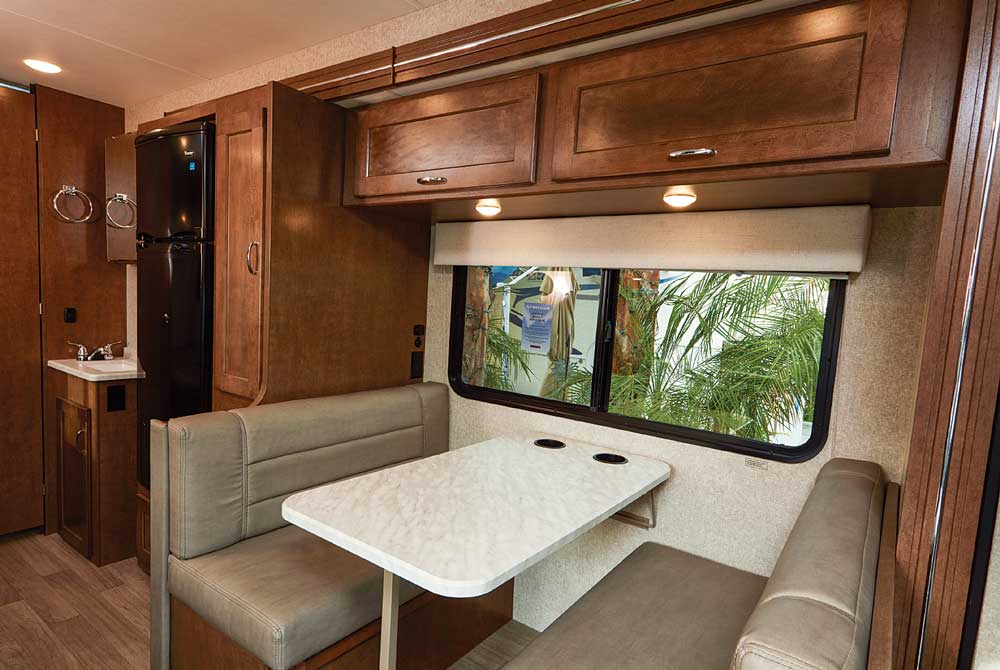
Dinette is roomy enough to seat four people. Expansive window provides a good view of the outside. Pull-down window shades, LED lighting and spacious cabinets are welcome features. Photos by Scott Hirko
The six-cylinder turbodiesel engine may not be a barnburner, but the 188 ponies do a credible job keeping up with fast-moving traffic (a California trademark), and since the engine sips fuel, the smiles get even bigger during fill-ups. Supporting the drivetrain is a smooth, yet sturdy suspension, providing a comfortable and sporty ride without creating undue roughness and the jitters associated with passing big rigs. This is an important factor for newbies who have heard stories about roadway stability issues in wind and around commercial trucks.
Exterior styling follows the lines of a more conventional Class C, whereas the cabover portion is larger to accommodate a bigger sleeping area above the cockpit. While not as aerodynamic as Sprinter-based motorhomes with more radical sloping front caps, the Vita is by no means bulky looking, and the extra space will be welcome for families with youngsters who relish the up-high sleeping area. A single slideout enhances floor space enough to ward off claustrophobia and the motorhome is nicely equipped with self-containment features that make off-grid (think National and State parks) possible. These consist of industry-leading capacities for its class with a 37-gallon freshwater tank, a 41-gallon black tank, a 41-gallon gray tank and 12.2 gallons of LP-gas capacity. Top it all off with a pair of Group 31 12-volt deep-cycle AGM batteries, a 55-amp power converter, a 1,000-watt inverter, a Cummins Onan LP-gas generator and a 200-watt solar system, and the Vita can easily forgo hookups for a reasonable length of time. To use the Vita 24F to its fullest, add a dinghy, like a two-door Jeep Wrangler, to the 5,000-pound-rated hitch receiver and families can make the most out of every RV outing.
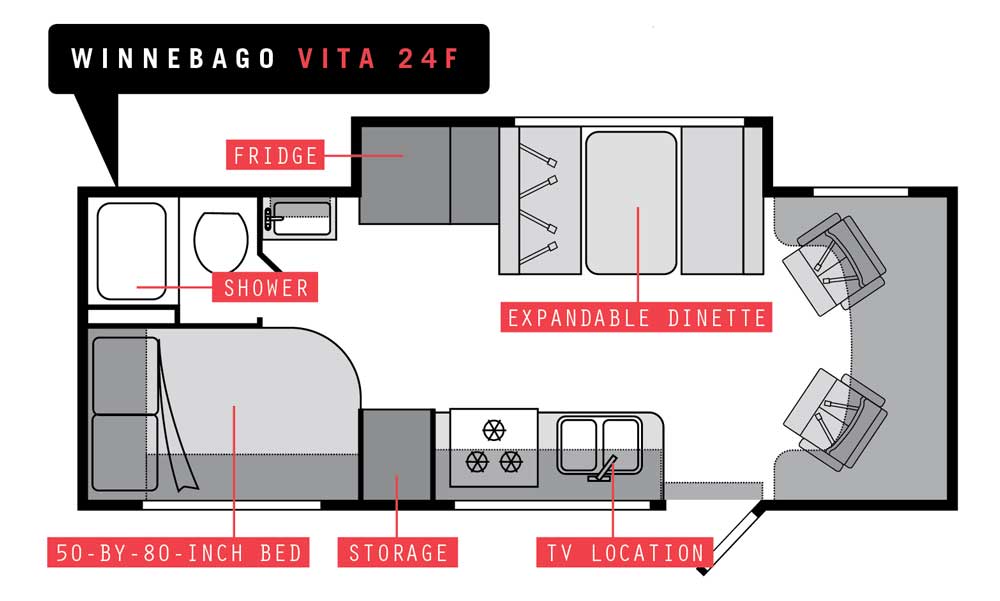 Just because the rig is compact doesn’t mean it’s not built using Winnebago’s well-known construction features. A specially crafted strong, lightweight body and SuperShell Sleeper Deck cabover structure, which adds strength and insulation, are ideally mated to the Sprinter chassis and offer a superb fit that exudes a higher build quality. Although you won’t find an excessive supply of extravagant, or even unnecessary, tech goodies, you will find everything necessary to get the job done.
Just because the rig is compact doesn’t mean it’s not built using Winnebago’s well-known construction features. A specially crafted strong, lightweight body and SuperShell Sleeper Deck cabover structure, which adds strength and insulation, are ideally mated to the Sprinter chassis and offer a superb fit that exudes a higher build quality. Although you won’t find an excessive supply of extravagant, or even unnecessary, tech goodies, you will find everything necessary to get the job done.
Specifications
Chassis
Model Mercedes-Benz Sprinter
Engine 3.0-liter turbodiesel
SAE hp 188 @ 3,800 rpm
Torque 325 lb-ft @ 1,400-2,400 rpm
Transmission Five-speed auto
Axle Ratio 3.92:1
Front Tires 215/85R16
Rear Tires 215/85R16
Wheelbase 170″
Brakes Disc/ABS
Suspension (F/R) Struts/leaf springs
Fuel Capacity 26.4 gal
Fuel Economy 17.9 mpg
Warranty 3 years/36,000 miles chassis; 5 years/100,000 miles engineCoach
Exterior Length 24′ 7″
Exterior Width 7′ 6″
Exterior Height with A/C 11′ 6″
Interior Width 7′ 3″
Interior Height 7′
Construction Aluminum frame with
steel supports, laminated walls with
block foam insulation, EPDM roof
Freshwater Capacity 37 gal
Black-water Capacity 41 gal
Gray-water Capacity 41 gal
Water-heater Capacity 6 gal
LP-gas Capacity 12.2 gal
Air Conditioner 13,500 Btu
Furnace 20,000 Btu
Refrigerator 7.3 cubic-foot residential
Inverter 1,000 watt
Converter 55 amp
Battery (1) 12-volt chassis,
(2) 12-volt AGM house
AC generator 3.6 kW LP-gas
MSRP (approximate) $120,000
Warranty 12 months/15,000 miles basic; 36 months/36,000 miles structureWet Weight
(water & heater, fuel, LP-gas tanks full; no supplies or passengers)
Front axle 3,740 lbs
Rear axle 5,820 lbs
Total 9,560 lbsChassis Ratings
GAWR, F/R 4,410/7,720 lbs
GVWR/GCWR 11,030/15,250 lbs
ROCCC 1,470 lbs (deduct weight of
passengers for net cargo capacity)GAWR Gross Axle Weight Rating
GVWR Gross Vehicle Weight Rating
GCWR Gross Combination Weight Rating
ROCCC Realistic Occupant and Cargo Carrying Capacity (full water, no passengers)
The exterior attractions are supported by a 15-foot powered patio awning with LED lights for mellow and effective night vision. A selection of lighted outside compartments, ranging from a significantly sized rear compartment to a smaller, but fairly deep bin (configured horizontally) keep camp supplies organized. There’s easy access for winterizing the water system, and the controls for the stabilizing jacks can be found on the wall inside the bigger locker. The Canyon deluxe graphics package adds handsome aesthetics to the exterior.
Hardware for the basic hookups is easy to reach, and there’s a freshwater gravity fill for filling the water tank, which adds primitive-camping versatility. The power cord for the 30-amp system is nicely secured into its own little locking compartment; it has to be plugged into the side-mounted receptacle when using the generator. Even though the sewer access is open and easy to find, it sits too low and is rather difficult to reach without the need to crawl around on your hands and knees; it could benefit from a relocation exercise.
Inside, the décor is somewhat understated, relying on more natural tones in brown and tan, but the elements are traditional and work well, even with a family of four moving about. Attention is quickly drawn toward the cockpit, shaded in a light gray with darker colors used for the captain’s chairs, dash and trim. Taking note from the driver’s seat, you won’t find anything luxurious. Instead, the elements — like the rubber floor mat instead of carpet or the mostly blank dash housing only driving essentials — help shave dollars from the sticker price. While the cockpit seats feel durable, after a short while, finding a comfortable spot takes some posterior fine-tuning and acclimation to the adjustability features. However, while directing the Vita down the highway, the driver has an excellent view of the open road and the controls, which are very ergonomic.
Directly above the cockpit controls is the largest overhead bed offered in a Sprinter-based Class C, measuring 49-by-87 inches. Two kids will find enough room to keep from tangling up and the area offers a playful respite for the little ones. Two adults can snuggle up there in a pinch; the out-of-the way sleeping area can be a blessing in a compact motorhome. The mattress, though, doesn’t contribute much to a restful sleep since its thickness is less than optimum. Using a memory foam pad can add comfort without cutting into the very-generous space between the ceiling and mattress. The bunk area could be dolled up with the addition of a front window to feel more open and provide a little outdoor gazing for those sleeping up there.
Seating in the living area is limited to the dinette cushions unless the cockpit seats are swiveled toward the rear. The dinette is large for a motorhome this size and can seat four in relative comfort. There’s just enough elbowroom on the leatherette cushions, and the table works well within the floorplan. Large windows allow those seated on the dinette during travel (seat belts are provided) to see outdoors. Access to the back is fairly open, even with the single slideout retracted, which makes it easy to get to the bathroom while on the road. If additional sleeping quarters are required, the dinette can be converted into a 40-by-76-inch bed. Two youngsters can probably coexist here, but one would be more comfortable.
Situated immediately across from the dinette and within clear view of the seating is the galley counter and overhead cabinets that house the 32-inch HDTV. The medium-dark earth-tone cabinetry offers enough space for essentials, and the woodwork is more traditional than what’s found in many of the plans using European-styled laminates.
Although the TV is placed onto the cabinet door to make the best use of space, it would have been well worth the 2- or 3-inch loss of storage needed to recess it into the door and avoid the unwanted headaches from corner contact when using the sink.
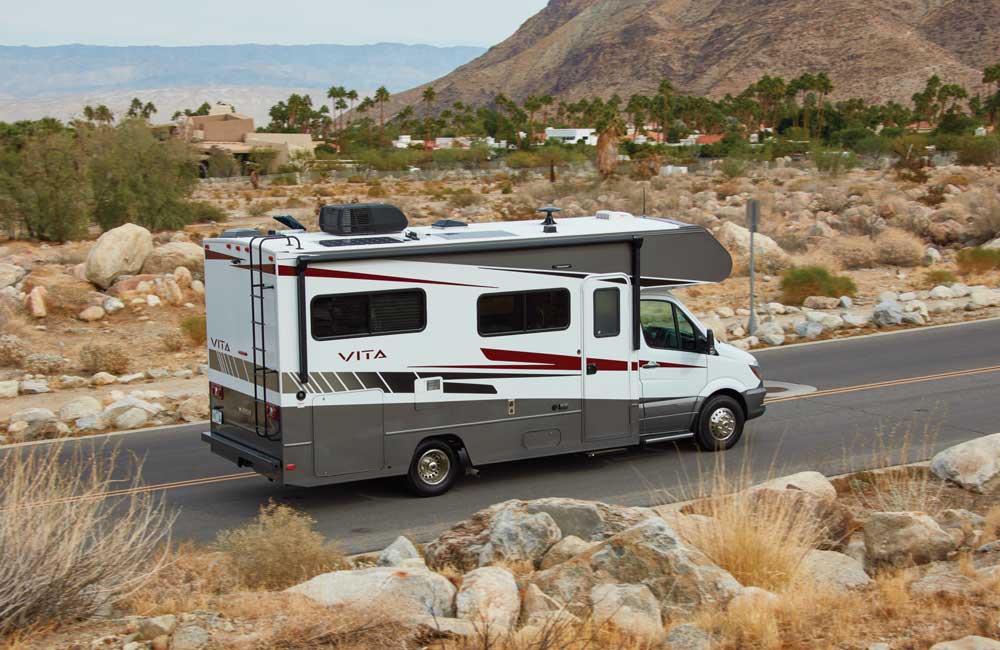
The Vita’s classic exterior profile is complemented by chrome wheel liners and a graphics package that’s not overstated.
The galley resides just below the TV. Complementing the two-segment sink are the usual implements for cooking, including a three-burner stove outfitted with a high-output burner up front, and a convection microwave to eliminate a redundancy of appliances and weight. Nicely nestled with the kitchen accouterments are a couple of drawers for silverware and spatulas, as well as an LED-illuminated spice rack and faux-tile backing to accent the wood cabinetry and black appliances. Luckily, the Vita comes with sink covers/cutting boards; otherwise, preparing meals on the virtually nonexistent counter would be somewhat of a struggle.
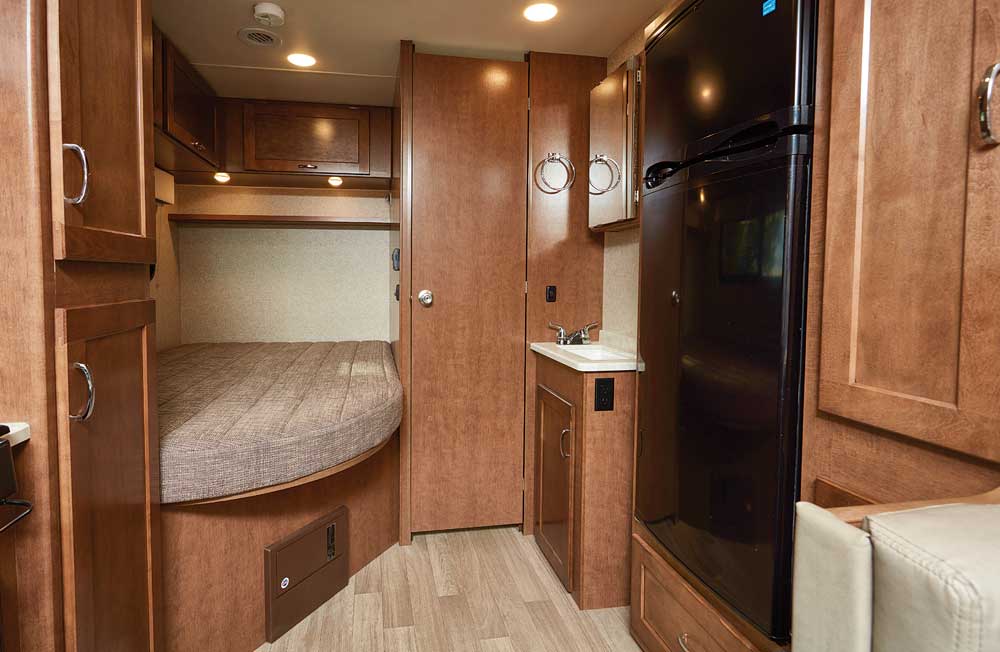
Rear corner bed offers decent comfort for two adults. Separate lavatory adds bathroom versatility. Compact residential refrigerator offers generous interior space.
What’s Hot
Large cabover bed, rear storage locker, large holding tanks, AGM batteries with a solar system, inside storage, drivability
What’s Not
Plastic hand-operated toilet, refrigerator-door latch, cabover mattress, TV mounting location
Positioned across from the galley, in the slideout, is a 7.3-cubic-foot residential refrigerator that holds more foodstuffs than the physical dimensions suggest. The aforementioned inverter can be called in for power when on the road and the refrigerator can be accessed with the slide retracted. As customarily done in the industry, some type of latching hardware is used to prevent the door from opening when on the road. Here, a clunky bolt with a large knob must be painstakingly screwed in to wedge the top and bottom doors closed. It’s certainly not a deal breaker, but somewhat out of sync with Winnebago’s usual engineering prowess.
Considering the overall space in a compact motorhome, the judicious use of cabinetry for keeping clutter off the floor and beds is well done. Among the cabinets is a Winnebago exclusive design that showcases its new multiuse storage “pantry” fitted with adjustable shelves that can double as a fairly tall closet for longer clothing. Opposing closets, across the multi-gray-color vinyl-clad aisle, provide additional storage.
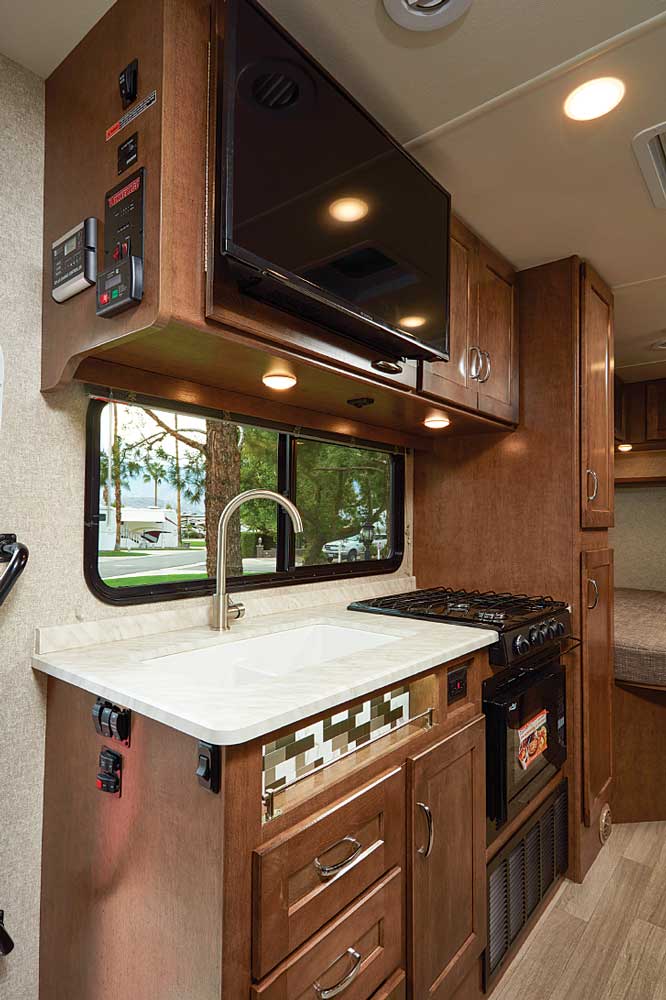
Galley is compact, but well-equipped. Sink covers provide additional counterspace for meal prep. Drawers and cabinets will handle more foodstuffs and supplies than expected. TV mounted on cabinet door above sink makes good use of space; recessing 2-3 inches inside the cabinet would prevent head knocking.
The rest of the interior is devoted to the “master” bedroom and separated bathroom facilities. On the right is a corner bed that is almost queen size. Even though the 50-by-80-inch foam mattress with the radius corner is not abundantly thick, it still provides a comfortable night’s sleep with just enough room for two adults to keep from slugging it out. The downside, of course, is that the person on the outside wall has to climb over the other person to get out of bed. But this configuration has been around for a very long time, and it makes good use of available real estate. Surrounding the bed are ample overhead cabinets, along with a handy shelf at the far end that’s outfitted with two LED ceiling lights and a power outlet.
Just outside the door to the enclosed toilet/shower room is a lavatory with a small sink and mirrored medicine cabinet above. The scheme is commonly used in the industry and is workable, offering versatility when multiple people need to use the facilities. Inside the enclosed area you’ll find a shower that supplies enough room to get the job done and an adjacent toilet. While the toilet position provides enough wiggle room to handle intended tasks, functionality leaves some room for improvement. The smaller all-plastic toilet is a hand-operated unit instead of a much-preferred foot-pedal model. It’s pretty low to the floor and seems like it’s flushing you along with the contents. Be prepared to dodge splashing water and for frequent, less-than-pleasant cleaning of the wall, door and bowl rim. An aftermarket upgrade to a porcelain-bowl model, while adding a little weight, will pay big dividends in comfort and usability.

Shower is right-sized, but the plastic toilet leaves something to be desired, as the hand-flushing mechanism feels out of place on a motorhome of this caliber.
With few exceptions, like the toilet choice, Winnebago did a good job orchestrating a Sprinter-based Class C without many of the frills that elevate costs, while maintaining a well-balanced amenity posture. The floorplan works fine for a family, and the HVAC systems do a good job moderating inside temperature. All things considered, the Vita is a solid value with a reasonable number of pleasantries thrown in to instill pride of ownership.
For More Information
Winnebago Industries
641-585-3535

